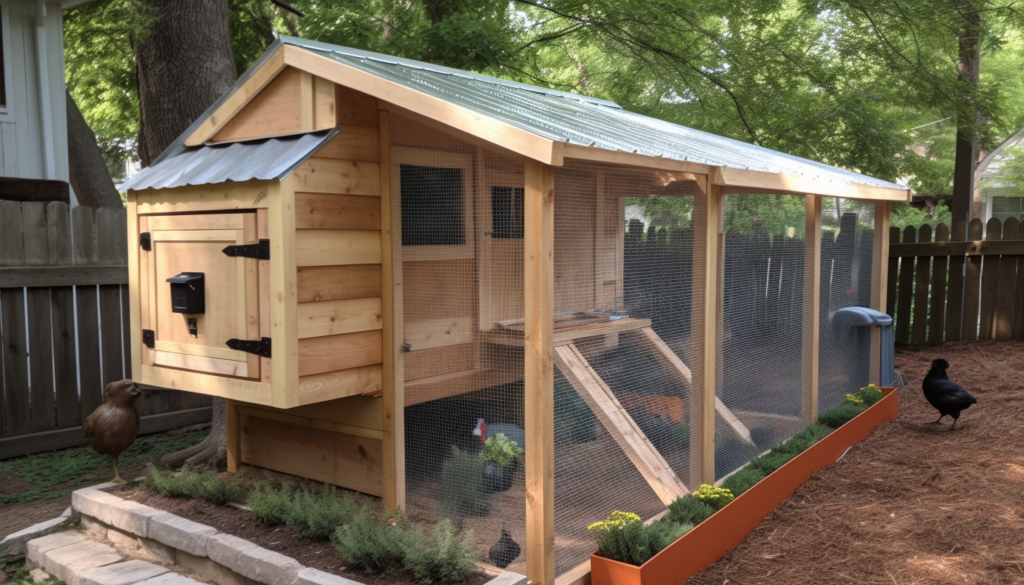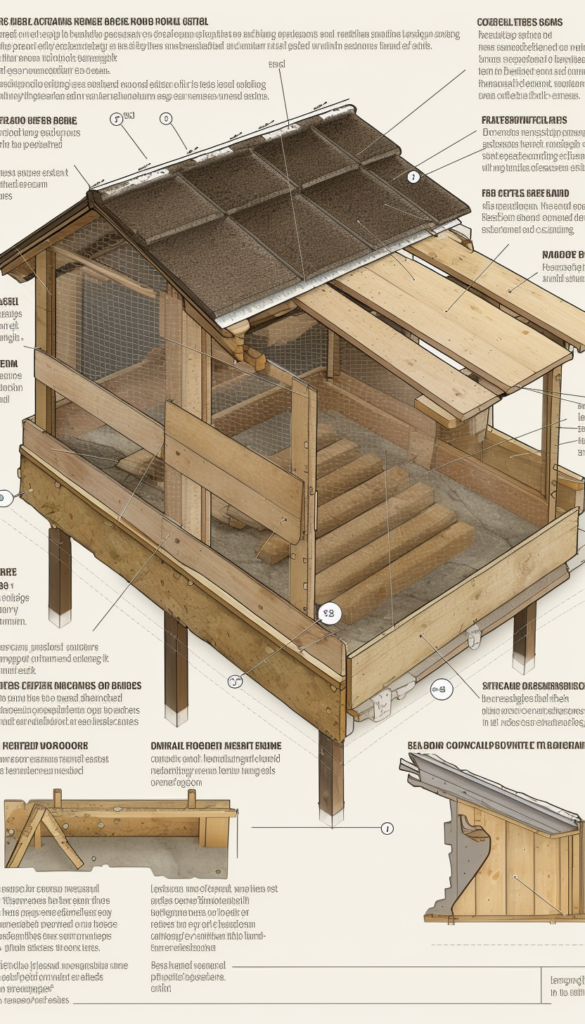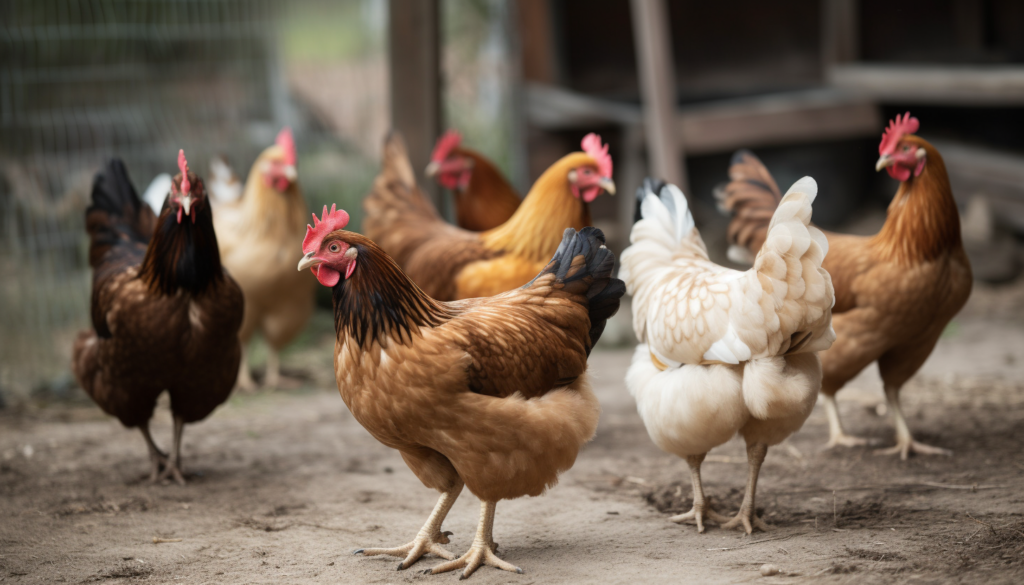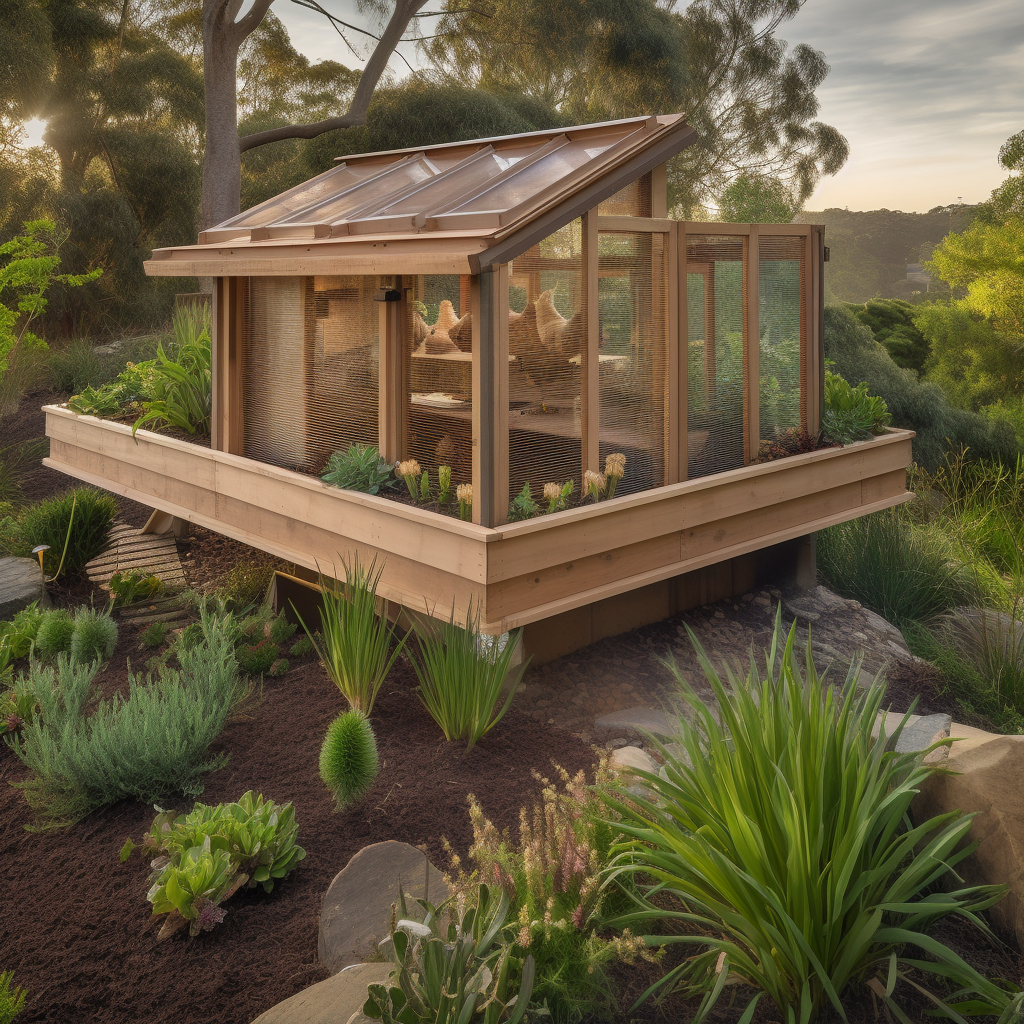So, you’ve decided to take the plunge and raise your own backyard chickens. Great choice! These feathery friends not only provide you with fresh eggs but also offer hours of entertainment. But before you can bring home your new pets, you’ll need to create a safe and comfortable space for them to live. This article will guide you through the steps of how to build a chicken coop for your backyard chickens. From planning to construction, we’ve got you covered. Let’s dive in, shall we?

Materials List for a Backyard Chicken Coop
To create a backyard chicken coop that will leave your neighbors green with envy, you’ll need the following materials:
- Lumber: 2x4s and 2x2s for the frame, and plywood for the walls and roof
- Hardware cloth: 1/2-inch wire mesh for ventilation and predator protection
- Galvanized screws and nails
- Hinges and latches: for doors and nesting box access
- Roofing material: shingles or corrugated metal
- Paint or wood stain: for weather protection and aesthetics
- Bedding material: straw or wood shavings
- Tools: saw, hammer, drill, wire cutter, and measuring tape
Step 1: Creating a Chicken Coop Blueprint: Laying the Groundwork

Before you begin, consider the number of chickens you plan to house. A general rule of thumb is to allow 4 square feet of coop space per chicken. Also, factor in an additional 10 square feet per chicken for the outdoor run. Sketch your coop design, including nesting boxes, roosts, and ventilation.
a. Assessing your needs and space Before you learn how to build a chicken coop for your backyard chickens, take a moment to evaluate your needs and available space. Consider how many chickens you plan to keep, as this will dictate the size of your coop. A good rule of thumb is to provide 3-4 square feet per bird in the coop and 10 square feet per bird in the run.
b. Researching local regulations and guidelines Before you start building, check your local zoning regulations and neighborhood rules. These may dictate the size, placement, and appearance of your chicken coop.
c. Sketching out a design Now that you have a better idea of your needs, sketch out a design that includes all the necessary elements: nesting boxes, roosts, proper ventilation, and predator-proofing. This blueprint will be your roadmap as you start building.
Step 2: Build the Frame
With your design in hand, start constructing the frame using the 2x4s and 2x2s. Create a sturdy foundation for the coop to rest upon, followed by the walls and roof. Make sure to incorporate a doorway for easy access to the interior.
a. Gathering the materials Once you have your design, gather the necessary materials, such as lumber, plywood, screws, and hardware. Don’t forget the essentials like a hammer, saw, and power drill.
Step 3: Add Walls and Roof
Using plywood, enclose the walls and roof. Create windows for ventilation, but ensure they’re covered with hardware cloth to keep predators at bay. For the roof, either use shingles or corrugated metal, ensuring it provides adequate protection from the elements.
a. Building the frame and walls Start by constructing the frame for your coop, followed by the walls. Ensure there’s adequate ventilation and insulation to keep your chickens comfortable year-round.
b. Installing the roof Choose a durable and waterproof material for the roof, such as asphalt shingles or metal roofing. This will keep your backyard chickens dry and protected.
Step 4: Construct the Run
Your chickens will need room to stretch their legs and forage. Build the run using 2x2s for the frame, and then enclose it with hardware cloth. Attach the run to the coop securely, and include a door for easy access.
Step 5: Install Roosts and Nesting Boxes
Inside the coop, create elevated roosting bars using 2x2s. Allow at least 8 inches of roosting space per chicken. Then, build nesting boxes for egg-laying, ensuring they’re easily accessible for collection. Line the boxes with straw or wood shavings for added comfort.
Step 6: Paint or Stain the Coop
To protect your coop from the elements and add a touch of personality, paint or stain the exterior. Choose a color that complements your backyard oasis, and let your creativity shine!
Step 7: Secure and Accessorize
Install hinges and latches on all doors for security and ease of access. Consider adding a predator apron around the base of the coop using hardware cloth, buried about 12 inches deep. Lastly, outfit the coop with feeders and waterers.
a. Predator-proofing your coop To keep your backyard chickens safe from predators, reinforce your coop with strong hardware cloth or welded wire. Cover all openings, including windows and vents, and bury the fencing at least 12 inches underground to deter digging predators. Install secure latches on doors and nesting boxes to prevent unwanted guests from sneaking in.
b. Chicken run: to build or not to build? A chicken run provides a secure outdoor space for your backyard chickens to exercise, forage, and bask in the sun. Building a run is optional, but it’s highly recommended to keep your chickens happy and healthy. If you choose to build one, ensure it’s predator-proof, using the same materials and precautions as your coop.
Step 8: Maintaining Your Chicken Coop: A Happy Home

To keep your coop in tip-top shape, clean it regularly by removing droppings, replacing bedding, and scrubbing feeders and waterers. Inspect the coop for damage or signs of wear and promptly make any necessary repairs.
a. Winterizing your coop In colder climates, winterize your chicken coop by adding extra insulation, sealing drafts, and providing a heat source, like a heat lamp, to keep your backyard chickens warm and toasty.
b. Spotting and dealing with pests Be vigilant for signs of pests, like mites or rodents, and take action immediately. Clean your coop thoroughly, treat your birds with appropriate products, and secure your feed storage to prevent future infestations.
Now that you know how to build a chicken coop for your backyard chickens, you’re well on your way to becoming a proud chicken parent. With a bit of planning, some elbow grease, and regular maintenance, you’ll have a secure and comfortable space for your feathery friends to thrive. Happy building and cluck on!
Backyard Chicken Coop Extras:

Comprehensive material list for a 6ft x 12ft x 8ft chicken coop:
- Lumber:
- (10) 2x4s x 8ft (for the frame, rafters, and roof supports)
- (4) 4x4s x 8ft (for the corner posts)
- (12) 2x6s x 12ft (for floor joists and roof beams)
- Plywood:
- (6) 1/2″ or 3/4″ plywood sheets x 4ft x 8ft (for flooring, walls, and roof sheathing)
- Roofing material:
- Asphalt shingles or metal roofing sheets (enough to cover a 6ft x 12ft roof)
- Hardware cloth or welded wire mesh:
- Approximately 200 square feet (for ventilation openings, windows, and chicken run fencing)
- Miscellaneous hardware and fasteners:
- 3″ wood screws (2-3 lbs)
- 1-1/2″ wood screws (1 lb)
- Galvanized nails (1 lb)
- 1/4″ or 3/8″ staples (1 box)
- (8) 1/2″ x 8″ galvanized carriage bolts, washers, and nuts (for securing corner posts)
- (2-4) heavy-duty hinges (for doors)
- (2) latch sets (for doors and nesting box access)
- (8) L-brackets (for reinforcing corners and joints)
- Nesting boxes and roosts:
- (2) 1x12s x 8ft (for nesting boxes)
- (3) 2x4s x 6ft or wooden dowels with 1.5″ diameter x 6ft (for roosts)
- Insulation and ventilation:
- Rigid foam insulation or batt insulation (optional, for insulation)
- Soffit vents, gable vents, or ridge vents (for ventilation)
- Windows and doors:
- Plexiglass or window glass (for windows, optional)
- (1) pre-made door or additional lumber and plywood to build a custom door
- Paint or wood stain:
- Exterior-grade paint or wood stain (to protect and beautify the coop)
- Tools (if not already available):
- Circular saw or handsaw
- Power drill
- Hammer
- Level
- Tape measure
- Square
- Staple gun
Please note that the material list provided is a rough estimate based on the specified dimensions. Adjust the quantities as needed depending on your specific design and requirements. Additionally, always double-check your measurements and design before purchasing materials to avoid waste or shortages.
FAQ’s About Building a Backyard Chicken Coop
How much space do my chickens need in the coop?
Generally, you should provide 3-4 square feet of space per chicken inside the coop. This ensures they have enough room to move around comfortably and prevents overcrowding.
How big should the chicken run be?
Aim for 10 square feet of space per chicken in the run. This allows them to roam, forage, and get exercise while remaining safe from predators.
How many nesting boxes do I need for my chickens?
Provide one nesting box for every 3-4 hens. This ensures that they have enough space to lay their eggs comfortably without competing for space.
What type of flooring should I use in my chicken coop?
Consider using materials like concrete, plywood, or hardware cloth for flooring. These are easy to clean and provide a barrier against predators.
How can I ensure proper ventilation in my chicken coop?
Incorporate vents, windows, or openings in your coop design, ensuring they’re covered with hardware cloth or welded wire mesh to prevent predator entry. This allows for adequate airflow while keeping your chickens safe.
What materials are best for building a chicken coop?
Choose sturdy, weather-resistant materials such as treated lumber, plywood, and hardware cloth. Opt for a durable and waterproof roofing material like asphalt shingles or metal roofing.
How do I predator-proof my chicken coop?
Reinforce your coop with strong hardware cloth or welded wire, covering all openings including windows and vents. Bury fencing at least 12 inches underground to deter digging predators, and install secure latches on doors and nesting boxes.
Do I need to insulate my chicken coop?
Insulation may be necessary if you live in a region with cold winters. Use materials like rigid foam insulation or batt insulation to help maintain a comfortable temperature for your chickens.
How often should I clean my chicken coop?
Clean your coop regularly by removing droppings, replacing bedding, and scrubbing feeders and waterers. Performing a deep clean at least once or twice a year is also recommended.
Can I build a chicken coop using reclaimed materials?
Yes, you can build a chicken coop using reclaimed materials like pallets, old fencing, or repurposed wood. Just make sure the materials are structurally sound and free from chemicals or contaminants that could harm your chickens.




Leave a Reply